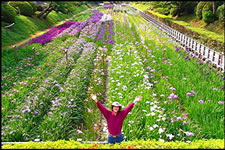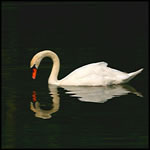Gary's Parries "Top Ten 2006"
 This week’s Gary’s Parries “Top Ten 2006” categories are:
This week’s Gary’s Parries “Top Ten 2006” categories are:
1. BIGGEST GEEK: How To Include Yourself In Your Own Photos
2. BIGGEST TURN-ON: Fashion Model Seeks Fun-Loving Digital With Long Zoom
3. MOST PARRIES: Image Sensor Sizes ‘Explained’
4. BEST HOAX:
a. (Hook) Bridge Camera Records Digital Images To Film
b. (Line) New CCD Achieves ISO 6.4 Million !!!
c. (Sinker) April Fools
5. MOST EGG ON FACE: That’s No Problem, That’s A Nikon D50 Feature
6 CUTEST PHOTO:
a. (Original) Red-Eye Guaranteed, Or Your Money Back
b. (Follow-Up) No Red-Eye, I Want My Money Back
7. BIGGEST HYSTERIA: Artistic Photos Gone Wild
8. BEST NON-CAMERA: Telecaster Or Stratocaster
9. BEST CATCH:
a. (Winner) My First Ever Mistake
b. (Runner-Up) Animal Cruelty
10. BEST COMPLIMENT: I’ve Just Seen A Face
11. MOST TECHNICAL:
a. (Winner) The Sharper Image
b. (Runner-Up) CIS Versus CCD
Introducing this week’s Gary’s Parries column. Everything you always wanted to know about digital cameras, but were afraid to ask. No question too difficult, or too easy. As a Senior Principal Software Engineer, and a former Assistant Professor of Computer Information Systems, as well as a recording studio owner/operator, inventor, and now, a digital camera enthusiast, GARY has more digital camera knowledge in his entire brain than most people have in their little finger. In the unlikely event that GARY would not know the answer to your question, he will answer it anyway, true to the spirit of the word “Parries”, a fencing term which, in this context, implies “cleverly evasive answers”. So let your imagination run wild. Email all your nagging digital camera questions to: [email protected], and then, En Garde!
You may also attach to your email an ORIGINAL PHOTO of your choosing. A preview of the photo will be displayed with your question, and a full-sized version will be just a click away. No personal information will be published with your question unless you specifically include it in the text or attached photo of your email, which may be further edited for grammar, content, or other reasons.
***
*** CATEGORY 1—- BIGGEST GEEK
***
QUESTION: HOW TO INCLUDE YOURSELF IN YOUR OWN PHOTOS
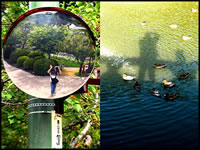 I prefer to vacation alone. It’s not that I am anti-social, it’s just that I don’t like interacting with other people in social situations. Even so, I do enjoy taking pictures of the many different sights I encounter in my travels, but the problem is, none of the pictures I take ever have me in them. I have tried shooting self-portraits at arm’s length with the desired sights in the background, but I often misjudge their framing, and end up with some part of me cut out of the picture. How can I avoid this problem? My camera does not have a fold-out LCD, or a wide-angle lens.
I prefer to vacation alone. It’s not that I am anti-social, it’s just that I don’t like interacting with other people in social situations. Even so, I do enjoy taking pictures of the many different sights I encounter in my travels, but the problem is, none of the pictures I take ever have me in them. I have tried shooting self-portraits at arm’s length with the desired sights in the background, but I often misjudge their framing, and end up with some part of me cut out of the picture. How can I avoid this problem? My camera does not have a fold-out LCD, or a wide-angle lens.
John
[Self-portrait photos courtesy of Nick in Japan – Ed.]
ANSWER: HOW TO INCLUDE YOURSELF IN YOUR OWN PHOTOS
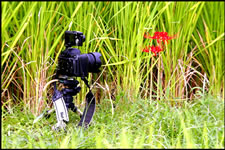 John, try practicing at home in front of and facing a mirror. Hold your camera at arm’s length and point it at yourself while observing the camera’s LCD in the mirror until you get the desired framing. Then lower your arm, and once again try positioning the camera for the desired framing. Check the LCD in the mirror to see if you were close. Repeat this process until you are able to return the camera to the desired position each and every time. Either that, or get a friend.
John, try practicing at home in front of and facing a mirror. Hold your camera at arm’s length and point it at yourself while observing the camera’s LCD in the mirror until you get the desired framing. Then lower your arm, and once again try positioning the camera for the desired framing. Check the LCD in the mirror to see if you were close. Repeat this process until you are able to return the camera to the desired position each and every time. Either that, or get a friend.
[‘Just Friends’ photo courtesy of Nick in Japan – Ed.]
***
*** CATEGORY 2—- BIGGEST TURN-ON
***
QUESTION: FASHION MODEL SEEKS FUN-LOVING DIGITAL WITH LONG ZOOM
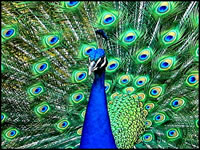 Gary, are you really married? My name is Jennifer and I’m a 29-year-old fashion model with an interest in digital photography. I would like to purchase a digital camera, one I can keep with me at all times, and use without a computer, just like you described for your ‘wife’. You seem to know quite a bit about digital cameras, and I was hoping you could turn me on to a good one.
Gary, are you really married? My name is Jennifer and I’m a 29-year-old fashion model with an interest in digital photography. I would like to purchase a digital camera, one I can keep with me at all times, and use without a computer, just like you described for your ‘wife’. You seem to know quite a bit about digital cameras, and I was hoping you could turn me on to a good one.
[For more information on the above referenced camera, go to PhotographyBLOG’s The Peoples Voice: “Take My Wife’s Digital Camera ... Please”. – Ed.]
[‘Flirting Peacock’ photo courtesy of Jaye. – Ed.]
ANSWER: FASHION MODEL SEEKS FUN-LOVING DIGITAL WITH LONG ZOOM
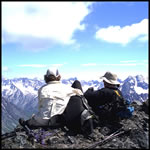 Jennifer, yes, I’m married to my lovely wife (whose name escapes me at the moment). Still, I would be very happy to help you with your problem, but I will need to know a little more about you, and your intended use of the camera. Are you looking for a compact with a long zoom? If so, get in line behind my wife. That seems to be the one aspect of compact cameras most troubling to manufacturers. I am hoping something suitable will be introduced at the PMA show coming up at the end of this month, and I will keep you posted. But don’t hold your breath. As I like to say, “I’ll see it when I believe it.”
Jennifer, yes, I’m married to my lovely wife (whose name escapes me at the moment). Still, I would be very happy to help you with your problem, but I will need to know a little more about you, and your intended use of the camera. Are you looking for a compact with a long zoom? If so, get in line behind my wife. That seems to be the one aspect of compact cameras most troubling to manufacturers. I am hoping something suitable will be introduced at the PMA show coming up at the end of this month, and I will keep you posted. But don’t hold your breath. As I like to say, “I’ll see it when I believe it.”
[‘Hikers On Cliff’ photo courtesy of Ward – Ed.]
***
*** CATEGORY 3—- MOST PARRIES
***
QUESTION: IMAGE SENSOR SIZES ‘EXPLAINED’
Your non slurred methods of explaining things are appreciated by many of us, and those of us that have been following your ramblings, and serious stuff, really need to have a comparison chart showing exactly what this old video tube sizing mystery is all about!
Please take us from the 1/2.7” camcorder, and maybe smaller, thru the common (ugh) 1/2.5”, the (16:9) 1/1.65”, 2/3”, Olympus 4/3rds, APS and up to the full frame 35mm, and bigger. A size chart will enable the real size relationships to take on a new meaning to a lot of folks, and maybe answer a lot of questions that may have developed.
Expanding on this may be a great article in regards to lens restrictions in relationship to image circles, and how your theory of the “impossible” use of APS sensors in pocket cameras has credibility. The last time I heard that word used was when my mother asked the waiter in the hotel in Tokyo, in 1986, if she could have her toast, toasted a bit more!
AA “Mensa Advanced Edition Dictionary” is not required for your response to this question. Thirty letter words may impress a lot of folks, but not me!
Respectfully submitted,
Nick in Japan
[‘Woman in Field’ photo courtesy of Nick in Japan – Ed.]
ANSWER: IMAGE SENSOR SIZES ‘EXPLAINED’
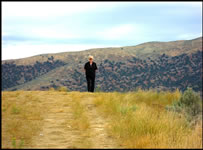 Nick, this as a very interesting question, one that obviously required a great deal of intelligent forethought on your part. I only wish that I could do it justice with an equally intelligent answer.
Nick, this as a very interesting question, one that obviously required a great deal of intelligent forethought on your part. I only wish that I could do it justice with an equally intelligent answer.
However, with all due respect to your mother, it would be “impossible” to engage in any type of meaningful discussion of these size designations without first engaging in at least a very basic discussion of the principles of Fourier Analysis, Solid State Physics, and Quantum Mechanics, while factoring in the effects of Black Holes, Global Warming, Darwin’s Theory of Evolution, and of course, The Big Bang Theory.
So, in order to avoid an exercise in futility, I will conclude by citing the Heisenberg Uncertainty Principle, which states that there is no absolute measurable “certainty” to these size designations other than as a short-hand notation to indicate, in complete accordance with Einstein’s Theory of Relativity, the proportions of one image sensor “relative” to another, thus avoiding the use of tedious nomenclature, such as “7.176 mm (width) x 5.319 mm (height)” for indicating the same.
BTW, although not nearly as informative (or impressive) as mine, there is an excellent discussion of image sensor sizes at DPReview.
[‘Woman on Hill’ photo courtesy of Gary – Ed.]
***
*** CATEGORY 4—- BEST HOAX
***
QUESTION A (Hook): BRIDGE CAMERA RECORDS DIGITAL IMAGES TO FILM
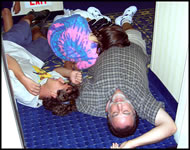 Any truth to the rumor of a soon-to-be-announced Sony bridge camera that records digital images to film? It all sounds a bit too good to be true.
Any truth to the rumor of a soon-to-be-announced Sony bridge camera that records digital images to film? It all sounds a bit too good to be true.
Regards,
AF
[‘Exhausted Family’ photo courtesy of Jaye – Ed.]
ANSWER A (Hook): BRIDGE CAMERA RECORDS DIGITAL IMAGES TO FILM
 AF, it does sound a bit too good to be true. Nonetheless, it definitely is true, except that it is not exactly a bridge camera, and it does not exactly record digital images to film.
AF, it does sound a bit too good to be true. Nonetheless, it definitely is true, except that it is not exactly a bridge camera, and it does not exactly record digital images to film.
To be more accurate, the camera is actually a Bridge/SLR (B/SLR) hybrid, with a fixed lens like a traditional bridge camera, and a reflex mirror for TTL viewing, which flips up from between the lens and film during image capture like a traditional SLR. However, unlike any other camera before it, this one immediately scans the unprocessed film to detect and store the captured image digitally.
The B/SLR utilizes a specially developed, “disposable” cartridge film, having all the resolution and dynamic range of traditional film, to capture a 1” x 1” square image, which is then immediately scanned into digital flash memory using a laser to detect the exposure-induced chemical changes in the unprocessed film.
The camera also has some fantastic specs. Its scanner resolution is 4800 x 4800 dpi, with a color depth of 48 bits, yielding 23 megapixel images with a 48-bit dynamic range. Its continuous shooting rate is a sustained 5 fps, limited only by the available CF and/or SD memory, and the number of exposures remaining. Disposable film cartridges of 100 and 200 exposures will be initially available.
The B/SLR will be available in a choice of factory-installed lenses with a variety of focal lengths and zoom ranges. Field installation of lenses is not possible due to the highly adverse effect of dust particles on the laser scanning system.
The camera is scheduled for release in June; however, due to the historical significance of this camera, PhotographyBLOG will dedicate the first Saturday of each month to a First-Look Hands-On Pre-Review of the camera, beginning in April.
[‘Album Cover’ photo courtesy of Nick in Japan – Ed.]
QUESTION B (Line)—- NEW CCD ACHIEVES ISO 6.4 MILLION !!!
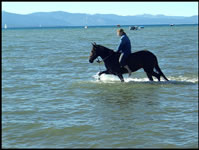 Is there any truth to the rumor of a new CCD that is capable of capturing high-resolution images in total darkness? It all sounds a bit too good to be true.
Is there any truth to the rumor of a new CCD that is capable of capturing high-resolution images in total darkness? It all sounds a bit too good to be true.
Regards,
AF
[‘Horse Walking on Water’ photo courtesy of Jaye – Ed.]
ANSWER B (Line)—- NEW CCD ACHIEVES ISO 6.4 MILLION !!!
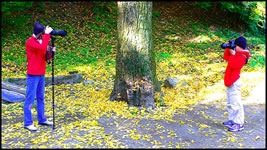 AF, it does sound a bit too good to be true. Nonetheless, it definitely IS true, except that it is not exactly a CCD and it does not exactly operate in total darkness.
AF, it does sound a bit too good to be true. Nonetheless, it definitely IS true, except that it is not exactly a CCD and it does not exactly operate in total darkness.
To be more accurate, the new sensor is a CIS (CMOS Image Sensor) that is 2000 times more light-sensitive than current CMOS Image Sensors of equivalent size. Assuming a current maximum ISO of 3200 for a traditional full-frame CIS, that would equate to ISO 6.4 MILLION (!!!) for the new image sensor.
This sensor uses a nanotechnology process called SMPD (Single-carrier Modulation Photo Detector), which makes it possible to take high-resolution images with as little as 0.1 lux (equivalent to one-tenth the brightness of a candle at one meter away in a totally dark room). What makes the SMPD even more amazing is that it uses standard CMOS technology, which means low power and low cost.
The first offering of the SMPD, which will be a smaller sized image sensor for use in CCTVs and camera phones, is scheduled for release April 1, 2006.
[‘Dueling Cameras’ photo courtesy of Nick in Japan – Ed.]
TOPIC C (Sinker)—- APRIL FOOLS
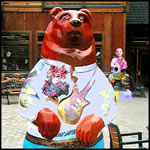 For anyone that was paying attention, in the March 19th Gary’s Parries, there was a question submitted by AF regarding the rumor of a bridge camera that records digital images to film. That was an April Fool’s joke.
For anyone that was paying attention, in the March 19th Gary’s Parries, there was a question submitted by AF regarding the rumor of a bridge camera that records digital images to film. That was an April Fool’s joke.
For anyone that was NOT paying attention, in the March 26th Gary’s Parries, there was another question submitted by AF regarding the rumor of a new CMOS image sensor that can achieve ISO 6.4 MILLION. That was NOT an April Fool’s joke (unless you count the fact that it was designed to fool you into thinking that it WAS an April Fool’s joke).
Here’s the proof: Planet82 SMPD Image Sensor to Spell the End of Flash?
HAPPY APRIL FOOL’s DAY !!! Hopefully, you were fooled at least once (if not twice).
[‘Bear Faced’ photo modification courtesy of Nick in Japan – Ed.]
***
*** CATEGORY 5—- MOST EGG ON FACE
***
QUESTION: THAT’S NO PROBLEM, THAT’S A NIKON D50 FEATURE
 Gary, I’m a newbie. Bought a Nikon D50 camera, and for some reason, when I take a photo, especially with a sky scene, or any bright parts, the bright parts appear black. Hope you can help.
Gary, I’m a newbie. Bought a Nikon D50 camera, and for some reason, when I take a photo, especially with a sky scene, or any bright parts, the bright parts appear black. Hope you can help.
Thanks,
Bert.
P.S. The printed photo is okay.
[‘Auto Face Elimination’ photo courtesy of Johnny – Ed.]
ANSWER: THAT’S NO PROBLEM, THAT’S A NIKON D50 FEATURE
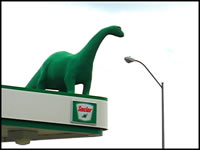 Bert, the Nikon D50 has 5 playback display modes for its rear LCD, the last one being a Highlights mode which alerts you to possibly overexposed areas of an image by turning them black and then flashing them On/Off. You must have inadvertently set this display mode, which the camera retains until you navigate to another display mode by pressing the Up/Down arrows of the 4-way Multi Selector (located just to the right of the LCD) while playing back your images.
Bert, the Nikon D50 has 5 playback display modes for its rear LCD, the last one being a Highlights mode which alerts you to possibly overexposed areas of an image by turning them black and then flashing them On/Off. You must have inadvertently set this display mode, which the camera retains until you navigate to another display mode by pressing the Up/Down arrows of the 4-way Multi Selector (located just to the right of the LCD) while playing back your images.
Don’t feel bad, Bert, it could have happened to anyone (but you really should read the D50 User’s Manual).
[Note: Solution provided by Rob Huberman at ComteQ Communications, LLC, who has admitted that he too has not read his D70 User’s Manual. – Ed.]
[‘Two Dinosaurs’ photo courtesy of Jaye – Ed.]
***
*** CATEGORY 6—- CUTEST PHOTO
***
QUESTION A (Original): RED-EYE GUARANTEED, OR YOUR MONEY BACK
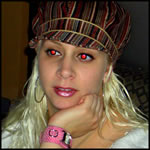 I recently became interested in digital photography, and have a Canon PowerShot A95, which I absolutely love! I have noticed, from time to time, that some of my flash shots are prone to red-eye, which I also happen to love! Is there any way that I can guarantee the occurrence of red-eye?
I recently became interested in digital photography, and have a Canon PowerShot A95, which I absolutely love! I have noticed, from time to time, that some of my flash shots are prone to red-eye, which I also happen to love! Is there any way that I can guarantee the occurrence of red-eye?
Thank you for your help.
Regards,
Lil LaRouge
[‘Red-Eyes’ photo courtesy of Lil LaRouge – Ed.]
ANSWER A (Original): RED-EYE GUARANTEED, OR YOUR MONEY BACK
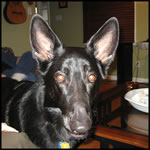 Lil (love your last name), this qualifies as one of the most unusual questions I have ever received; however, I understand completely, as I too find that I am similarly drawn to my own red-eye shots on occasion.
Lil (love your last name), this qualifies as one of the most unusual questions I have ever received; however, I understand completely, as I too find that I am similarly drawn to my own red-eye shots on occasion.
FYI, red-eye occurs when the light from the camera’s flash enters the subject’s pupils, strikes the red blood vessels of the retina inside each eye, and is then reflected back into the lens. Unfortunately, I know of no way to “guarantee” red-eye occurrence (short of fabricating it in post-processing); however, I can suggest several ways to increase the “probability” of its occurrence right out of the camera.
1. Offer subject ‘drinks’ to dilate their pupils and dull their pupillary response to light.
2. Reduce ambient lighting as much as possible to increase subject’s pupil dilation.
3. Use camera’s “internal” flash only.
4. Turn OFF camera’s red-eye flash mode (obvious, but needed to be said).
5. Set camera’s flash at maximum intensity to increase the amount of reflected light.
6. Set camera’s lens at maximum zoom to increase the distance from the subject.
7. Position camera at subject’s eye level to capture the most reflected light.
8. Have subject look directly at camera to direct reflected light into the lens.
9. Have subject close their eyes for 30 seconds just prior to flash to dilate their pupils.
Upon review of the photo, if the subject’s eyes show up purple rather than red, RUN !!! They are from another planet.
[‘Yellow-Eyes’ photo courtesy of Gary – Ed.]
QUESTION B (Follow-Up): NO RED-EYE, I WANT MY MONEY BACK
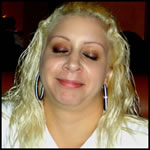 Gary, your nine steps to guaranteed red-eye, or your money back, did not work (see attached photo). What went wrong?
Gary, your nine steps to guaranteed red-eye, or your money back, did not work (see attached photo). What went wrong?
Regards,
Lil LaRouge
[‘No Red-Eyes’ photo courtesy of Lil LaRouge – Ed.]
ANSWER B (Follow-Up): NO RED-EYE, I WANT MY MONEY BACK
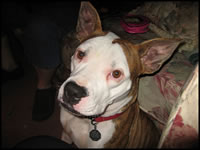 Lil, judging from your self-portrait, I think I see the problem. You may have gone a little overboard with step #1. To compensate for this, I have added one final step to the list, as follows.
Lil, judging from your self-portrait, I think I see the problem. You may have gone a little overboard with step #1. To compensate for this, I have added one final step to the list, as follows.
10. Have subject reopen their eyes before taking picture.
Try it now, Lil. Cheers!
[‘No Yellow-Eyes’ photo courtesy of Jaye.]
***
*** CATEGORY 7—- BIGGEST HYSTERIA
***
QUESTION: ARTISTIC PHOTOS GONE WILD
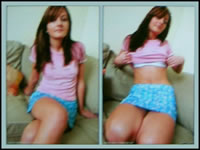 I’ve really enjoyed reading your parries and hope that you can help me with a rather delicate problem. My Nikon Coolpix 5900 had to be sent back to the manufacturer for a warranty repair (the LCD image was crooked). Unfortunately, I forgot to remove my memory chip before they shipped it out. My problem is that the chip contains 1 gig of ‘artistic’ photos of me taken by my husband. I am frantic that someone at Nikon will leak them to photography blogs all over the Internet. My husband, who is also a big fan of yours, was hoping that you might be able to intervene on my behalf. Do you have any prior experience in dealing with nude photos (see attached)?
I’ve really enjoyed reading your parries and hope that you can help me with a rather delicate problem. My Nikon Coolpix 5900 had to be sent back to the manufacturer for a warranty repair (the LCD image was crooked). Unfortunately, I forgot to remove my memory chip before they shipped it out. My problem is that the chip contains 1 gig of ‘artistic’ photos of me taken by my husband. I am frantic that someone at Nikon will leak them to photography blogs all over the Internet. My husband, who is also a big fan of yours, was hoping that you might be able to intervene on my behalf. Do you have any prior experience in dealing with nude photos (see attached)?
Sincerely,
LJH
[‘Hysteria’ photos courtesy of LJH – Ed.]
ANSWER: ARTISTIC PHOTOS GONE WILD
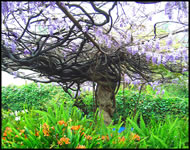 LJ, thank you so much for the flowers (and for the photos). I can totally sympathize with your dilemma, and the possible embarrassment it could cause you. However, judging from the photos you sent (the first two of which I have posted here), you have nothing to be embarrassed about.
LJ, thank you so much for the flowers (and for the photos). I can totally sympathize with your dilemma, and the possible embarrassment it could cause you. However, judging from the photos you sent (the first two of which I have posted here), you have nothing to be embarrassed about.
As such, I am making the remainder of the images available for review by our readers. Trust me on this LJ. I think it’s for the best.
[Note: Click here to download the full progression of images. – Ed.]
[‘Wisteria’ photo courtesy of Jaye – Ed.]
***
*** CATEGORY 8—- BEST NON-CAMERA
***
QUESTION: TELECASTER OR STRATOCASTER
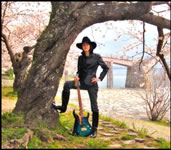 I’m sure you get quite a few questions that you would like to answer, but for one reason or another they don’t qualify for a Question/Answer spot in “Parries”. So, how about this one?
I’m sure you get quite a few questions that you would like to answer, but for one reason or another they don’t qualify for a Question/Answer spot in “Parries”. So, how about this one?
I have a collection of different types of guitars that I use for props, and of course a couple of them are Strats. I have been wondering for many years EXACTLY why a guitar player chooses a Telecaster versus a Stratocaster. I have never been able to get a believable answer, and I want to believe it is more than just random choice. Do you know the real reason? Is it something to do with tonal range, build quality, durability or what? It appears that the Telecaster is more popular.
Thanks for your consideration!
Semper Fi,
Nick
[‘Guitarist with Axe and Tree’ photo courtesy of Nick in Japan – Ed.]
ANSWER: TELECASTER OR STRATOCASTER
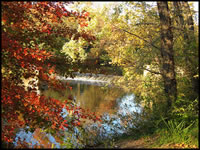 Nick, I’m answering this question because, BION, there are many similarities between choosing the right guitar and choosing the right camera.
Nick, I’m answering this question because, BION, there are many similarities between choosing the right guitar and choosing the right camera.
For example, one reason you might buy a camera is because you like the way it looks. Same with a guitar. Some regard the sleeker bodied Telecaster as a better looking guitar than the very traditional looking Stratocaster, much like a comparison of the Canon PowerShot SD700 IS and the Panasonic Lumix DMC-LX2.
Another reason you might buy a camera is because you like the way it feels. Same with a guitar. Some regard the Telecaster’s smoother, more rounded neck as a better feel than the boxy Strat, much like the smoother, more rounded Canon SD700 IS compared to the boxy Panasonic LX2.
Another reason you might buy a camera is because you like the way it responds. Same with a guitar. Some regard the Telecaster’s thinner neck as more responsive and easier to handle than that of the chunkier Strat, much like the thinner SD700 IS compared to the chunkier LX2.
Yet another reason you might buy a camera is because you like the quality of its output. Same with a guitar. Some regard the characteristic ‘clean’ twang of the Tele as a more pleasant, bluesy sound than that of the Stratocaster, much like the cleaner images of an SD700 IS compared to those of the noisier LX2.
But to be fair, another reason you might buy a camera is because you like its features. Same with a guitar. Some regard the Stratocaster as a more full-featured guitar than the Telecaster, much like the full-featured LX2, with its manual controls, TIFF/RAW shooting modes, and 28mm wide lens, compared to the strictly point-n-shoot SD700 IS.
Similarly, yet another reason you might buy a camera is because you want to stand out from the crowd. Same with a guitar. Some regard the Stratocaster’s diversity of tones as preferable to that of the one-trick-pony sound of the Telecaster, much like the diversity of compositions offered by the Panasonic LX2, with its wide angle lens and native 16:9 aspect ratio, compared to the standard lens and aspect ratio of the Canon SD700 IS.
There is, however, one reason you might prefer a Stratocaster to a Telecaster for which there is no analogy in the camera world, namely, the fact that superstar ‘Eric Clapton’ plays a Strat. The closest we can come to something like that at PhotographyBLOG is the fact that our good friend ‘Nick in Japan’ is currently out shooting with his new LX2 as we speak, and we will (hopefully) soon have a photo to fill the 16:9 spot that I have reserved just for him. :)
[‘Waterfall Through Trees’ photo courtesy of Jaye – Ed.]
***
*** CATEGORY 9—- BEST CATCH
***
QUESTION A (Winner): MY FIRST EVER MISTAKE
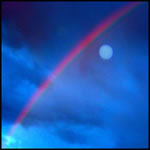 In your Gary’s Parries column intro, you say that you have more digital camera knowledge in your entire brain than other people have in their little finger. I guess you meant to say in your little finger vs. other people’s entire brain. You have it backwards - I hope.
In your Gary’s Parries column intro, you say that you have more digital camera knowledge in your entire brain than other people have in their little finger. I guess you meant to say in your little finger vs. other people’s entire brain. You have it backwards - I hope.
Dr J
[‘Rainbow Over the Moon’ photo courtesy of Jaye – Ed.]
ANSWER A (Winner): MY FIRST EVER MISTAKE
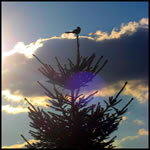 Dr J, being a doctor, I am sure you can understand that, as an obsessive-compulsive, I do not like to make mistakes; however, I am also sure you can understand that, as a dyslexic, I am highly prone to switch things around. So, in my own defense I would have to say, it was not so much an ‘error’ as it was my dyslexia talking (although that does not explain why our editors did not catch it :)).
Dr J, being a doctor, I am sure you can understand that, as an obsessive-compulsive, I do not like to make mistakes; however, I am also sure you can understand that, as a dyslexic, I am highly prone to switch things around. So, in my own defense I would have to say, it was not so much an ‘error’ as it was my dyslexia talking (although that does not explain why our editors did not catch it :)).
But, yes, instead of saying that I have more digital camera knowledge in my entire brain than most people have in their little finger (and really, who that reads this column would ever believe that), I should have reversed it and said that most people have more digital camera knowledge in their little finger than I have in my entire brain (which is much more believable).
I’ll speak to our editors, and hopefully we can get this resolved by next week’s column. Thanks, Dr J, for your input.
[‘Bird Atop Tree’ photo courtesy of Gary – Ed.]
QUESTION B (Runner-Up): ANIMAL CRUELTY
I noticed a picture in one of your recent columns, which displayed a somewhat large and vicious looking bird standing atop a Golden Retriever. Several people’s feet can be seen standing around enjoying the spectacle, whilst the hapless dog is forced to endure this obviously frightening and humiliating ordeal. I’m concerned this kind of photography will lead next to “cock-fighting”.
Signed: Very Worried
[Note: Photo republished from the November 12, 2006 Gary’s Parries. – Ed.]
[‘Bird on Dog’s Back’ photo courtesy of Jaye – Ed.]
ANSWER B (Runner-Up): ANIMAL CRUELTY
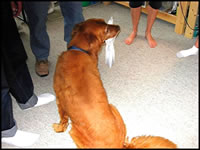 VW, rest assured, as one of the people’s feet in that picture, I can definitely, without the slightest bit of hesitation, attest to the fact that this was NOT an act of animal cruelty. In fact, Red-eye and Zoom are best of friends. Nobody had to place Zoom on Red-eye’s back, he frequently lands there on his own, and Red-eye loves it.
VW, rest assured, as one of the people’s feet in that picture, I can definitely, without the slightest bit of hesitation, attest to the fact that this was NOT an act of animal cruelty. In fact, Red-eye and Zoom are best of friends. Nobody had to place Zoom on Red-eye’s back, he frequently lands there on his own, and Red-eye loves it.
As for the insinuation this was the sort of seedy gathering you would find at a cockfight, that is the furthest thing from the truth. The scene in the photo is one of a normal family gathering to celebrate my friend’s recent return from China. My wife was the one taking the picture, and the other feet in the picture belong to my friend and his family.
On the evening of this photo, we all sat down to a wonderful family dinner, where the main course was a deliciously unusual dish prepared by my friend. He would not tell us what was in it, but he called it Red-Eye Pie.
[‘Bird in Dog’s Mouth’ photo modification courtesy of Nick in Japan – Ed.]
***
*** CATEGORY 10—- BEST COMPLIMENT
***
QUESTION: I’VE JUST SEEN A FACE
I have to tell you that your column is the first thing I turn to when I get on the computer (although once I was temporarily distracted by an amazing White Tiger photo). Anyway, thought you’d like to know.
As the photographic cartoonist in the UK’s Amateur Photographer magazine since 2004, I too was delighted to hear from a reader that they went straight to the cartoon every week before starting on the serious stuff.
My question: what does a camera do when it detects a face? No one seems to have mentioned that (in the October 22, 2006 Gary’s Parries, Question 1—- Face Detection For All Colors). Does it immediately apply essential cosmetic repairs? Report suspicious characters by Wi-Fi to the nearest police station? Add that face to photos of the same person in a particular folder?
With regard to your Gary’s Parries column intro, I particularly enjoy your parries to the occasional correspondent that comments, “I think you meant to say that you have more digital camera knowledge in your ‘little finger’ than most people have in their ‘entire brain’!” I wonder what it’s like for those people to be totally lacking in any sense of humour?
All good wishes,
Geoff Oakshott
[‘Face Detection 1’ photo courtesy of Nick in Japan – Ed.]
ANSWER: I’VE JUST SEEN A FACE
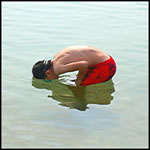 Geoff, thank you for the kind words and wishes. It is certainly nice to hear when your work is appreciated. As for the occasional correspondent that offers their correction to the Gary’s Parries column intro, I often wonder, could it be that it is ‘their’ humor that is going over ‘my’ head?
Geoff, thank you for the kind words and wishes. It is certainly nice to hear when your work is appreciated. As for the occasional correspondent that offers their correction to the Gary’s Parries column intro, I often wonder, could it be that it is ‘their’ humor that is going over ‘my’ head?
In the October 22, 2006 Gary’s Parries, we discussed how a camera might perform face detection, but as you pointed out in your question, we never discussed what the camera would do with that information. The answer is, it depends on the camera.
For example, the Fujifilm FinePix S6000fd (a.k.a. S6500fd) was the first digital camera to feature ‘hardware’-based face detection. Upon its simultaneous detection of up to 10 faces, the camera prioritizes them, and then adjusts its settings for the proper focus and exposure of the highest priority face(s). The camera also tracks the face(s) to ensure they remain focused throughout their movement in the frame. And because Fuji’s face detection is totally hardware based, it can complete all this functionality within 40 ms.
There are also ‘software’-based face detection systems for digital cameras. While these cannot equal the performance of hardware-based systems, they often provide more functionality due to the flexibility provided by the ease of programming these features in software versus fabricating them in hardware. FotoNation, a world leader in embedded digital camera software, has developed a face detection system, called Face Tracker, that not only ensures the proper focus, exposure, and tracking, but also the proper color balance for the detected faces.
FotoNation has also ported its Face Tracker to camera phones, and given it even more functionality. Not only do the camera phones automatically adjust focus, exposure, and color balance, all while tracking up to 8 faces with performance comparable to that of digital cameras, but they also feature “automatic image orientation, face cropping, and face thumbnail generation for use in the phone’s contact address book.”
As face detection algorithms continue to advance, and cameras continue to utilize more powerful processors, it is conceivable, as you suggest, that cameras may someday be able to automatically remove the wart from a person’s nose. :)
P.S. I’ll bet that you have some interesting cartoons for this day. Remember, remember the 5th of November.
[‘Face Detection 2’ photo courtesy of Nick in Japan – Ed.]
***
*** CATEGORY 11—- MOST TECHNICAL
***
[WARNING: Category 11 contains highly technical discussions. If you are uninterested in such discussions, please skip to Category 12, Best Nude Photos. – Ed.]
QUESTION A (Winner): THE SHARPER IMAGE
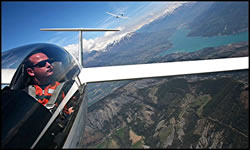 Gary, has a 7MP camera better sharpness when set to 5MP, than a 5MP camera at its best resolution?
Gary, has a 7MP camera better sharpness when set to 5MP, than a 5MP camera at its best resolution?
Regards,
Anders Tiberg
[Self-portrait photo courtesy of Nick Smith, RAF Gliding Association – Ed.]
ANSWER A (Winner): THE SHARPER IMAGE
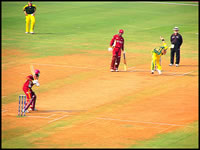 An excellent question, Anders, the answer to which would normally require solving a set of simultaneous quadratic equations in order to find the eigenvalues of the associated sharpness matrix for the given resolutions. However, so as not to put anyone off, I will instead answer your question with some simple propositional logic, using the modus ponens inference rule. First, a bit of background info to make sure that we are all on the same page.
An excellent question, Anders, the answer to which would normally require solving a set of simultaneous quadratic equations in order to find the eigenvalues of the associated sharpness matrix for the given resolutions. However, so as not to put anyone off, I will instead answer your question with some simple propositional logic, using the modus ponens inference rule. First, a bit of background info to make sure that we are all on the same page.
Contrary to intuition, image sharpness is independent of image resolution. The apparent sharpness of an image is determined solely by the abruptness of the changes in pixel brightness across the edges of detail in an image. Sharpening artificially makes those transitions more abrupt by further lightening pixels on the lighter side of the detail edge, and simultaneously further darkening pixels on the darker side of the detail edge.
Image noise can have a negative impact on sharpening due to the fact the false edges of the noise detail will be further exaggerated by the sharpening. Because image noise is so counterproductive to sharpening, it severely limits the amount of sharpening that can be applied to an image before artifacts begin to appear. Thus, when comparing the sharpness of images with different resolutions, it becomes a matter of which image has a higher maximum sharpening capability before such artifacts become objectionable.
Now on to your question regarding the sharpness of a 5-megapixel, ‘reduced’-resolution image being obtained from a 7-megapixel CCD, compared to that of a 5-megapixel, ‘native’-resolution image obtained from a 5 megapixel CCD.
Given that an image with higher noise is less conducive to sharpening than an image with lower noise, and given that a higher resolution CCD produces noisier images than a lower resolution CCD of the same size due to its smaller pixel size, it follows that a reduced-resolution image will be noisier than an equivalent native-resolution image due to its smaller pixel size, and that such an image will therefore be less conducive to sharpening, which leads to the conclusion that a 5-megapixel, native-resolution image sharpened to its maximum before objectionable artifacts appear will be sharper than a 5-megapixel, reduced-resolution image similarly sharpened to its maximum, all other things being equal. QED
[‘Cricket’ photo courtesy of Aditya Govindarajan – Ed.]
QUESTION B (Runner-Up): CIS VERSUS CCD
Gary,
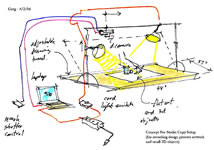 I have a question about digital camera image sensors. Could you please explain the difference between a CIS and a CCD?
I have a question about digital camera image sensors. Could you please explain the difference between a CIS and a CCD?
Thanks,
Peter
[‘Studio Concept’ photo courtesy of Greg – Ed.]
ANSWER B (Runner-Up): CIS VERSUS CCD
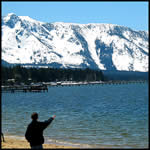 Peter, I can answer that question in just one sentence.
Peter, I can answer that question in just one sentence.
A CIS (CMOS Image Sensor) works differently than a CCD (Charge Coupled Device) which, as the name implies, processes the analog electrical charges that have accumulated at each photosite as a result of, and in proportion to, the light intensity at the photosite, such that all charges are shifted vertically, an entire row at a time, into a holding buffer where they are then shifted horizontally, one pixel at a time, into an output buffer where the pixel’s electrical charge is amplified, converted to a digital voltage, and then stored in digital memory in order to make room for the next pixel to receive such processing, processing which you would expect to be highly susceptible to errors, considering all the errors that would be introduced in an analogous situation of measuring a bucket’s water level by first transferring its water into and out of literally thousands of buckets in sequence, that situation being in complete contrast to CMOS Image Sensors, which employ the same circuit technology utilized in many tens of thousands of other CMOS circuit types already on the market, and not just in cameras, as is the case with CCDs, thereby making it economically feasible to integrate the additionally required circuitry at each photosite of the CMOS Image Sensor, for not only buffering and amplifying its electrical charge, thus enabling individual access to each photosite using a simple x-y addressing scheme, that is far less susceptible to errors than CCD charge transfers, but also for implementing hardware noise reduction circuitry which, unlike its software noise reduction counterpart, will not degrade image detail in the least, leaving one to conclude that, while there are many advantages to CMOS Image Sensors over CCDs, these advantages could all be lumped into one of the following two major categories: (1) advanced circuit technology, and (2) economies of scale.
[‘Lake Tahoe’ photo courtesy of Jaye.]
***
TO ALL—- A VERY HAPPY AND PEACEFUL 2007 NEW YEAR !!!—- LET YOUR CAMERA BE YOUR PEEPERS AND ALL YOUR PHOTOS WILL BE KEEPERS. :)
***
[Column photo “The Photographer” by Brenda LaFleur of Brenda LaFleur Photography.]

